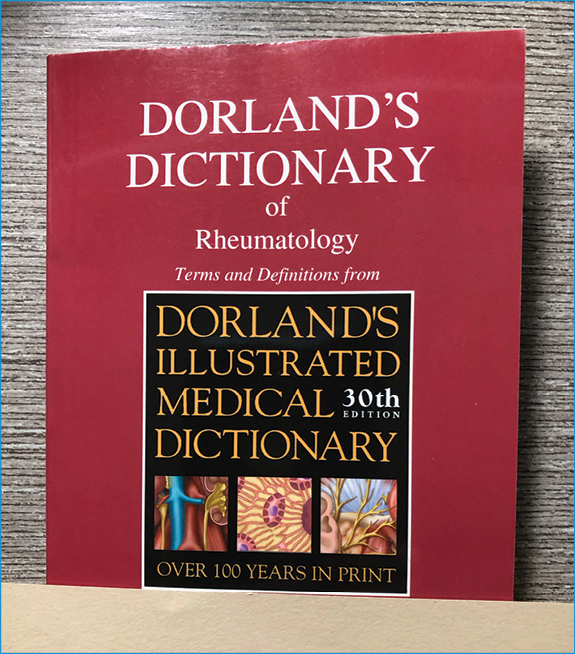Summer 2024 (Volume 34, Number 2)
Progress in Rheumatology:
How Far Have We Come?
By Philip A. Baer, MDCM, FRCPC, FACR
Download PDF

Twenty years ago, I attended a rheumatology conference, probably the American College of Rheumatology (ACR) meeting, and spent some time visiting various industry booths between sessions. Freebies were the norm in those days. Cleaning out some drawers at the office recently, I came across one of them: “Dorland’s Dictionary of Rheumatology.” I remembered giving it to my secretary to consult when typing letters and as a general reference. Maybe she used it, maybe not: it looked in mint condition and, at this point, its relevance was likely limited. But before consigning it to be recycled, I decided to inspect it to get a snapshot of how rheumatology looked to the authors in 2004.
The compendium was interesting both for what was included and what was not. The word “biologic” did not appear, though infliximab and etanercept had already been available for 5-6 years. “Apiotherapy” and “melissotherapy” were both included, as there had been some interest in bee venom therapy for rheumatoid arthritis (RA) at the time. “Chrysotherapy”, “aurotherapy” and “oleochrysotherapy” all reference gold treatment for RA, which was already in marked decline by 2004, but methotrexate does not appear. Page 1 included multiple terms I was unfamiliar with, including “acampsia” (rigidity or inflexibility of a part or of a joint), “acnemia” (atrophy of the calves of the legs), and “acrocinesis” (excessive motility; abnormal freedom of movement). The penultimate page covered “Volkmann’s subluxation” (a type of tuberculous arthritis) and “white tumour” (chronic tuberculous arthritis). In between I encountered a very large number of terms related to gout: “urarthritis”, “uarthritis”, “arthrolithiasis”, “anconagra”, ”omagra”, “cheiragra”, “pechyagra”, “gonagra”, and “podagra” (that latter one was familiar).
Did I recognize “anconitis” as inflammation of the elbow joint? No. “Arthroncus”, “arthrocele”, and “arthrophyma”, all meaning swelling of a joint? No. Eponyms were far more commonly listed than they would be now. We won’t miss having to remember the actual conditions represented by Albers-Schonberg, Albright, Bechterew, Marie-Strumpell, Poncet, Hench-Rosenberg and many others. Oddly, “Sjogren’s Syndrome”, which is a survivor, was not defined. The definition of “collagen disease” included not only what we now call SARDs (systemic autoimmune rheumatic diseases) but also RA, and was not to be confused with “collagen disorder”, which was not defined. Jack Cush includes “connective tissue disease” among the terms that belong in the Rheumatology Dead Word
Cemetery1, and we may as well bury “collagen vascular disorder” at the same time. Fortunately, he also interred SAARD (slow acting anti-rheumatic drug) which could easily be confused with the now accepted SARD.
I doubt “sacroiliac disease” was ever defined as “chronic tuberculous inflammation of the sacroiliac joint” but that’s what I found in this supposed reference book. Similarly, “seronegative RA” was defined as “any of various rare types of RA in which patients are seronegative for rheumatoid factor (RF).” A 25% frequency of having a negative RF in RA is hardly rare! Finally, "systemic lupus erythematosus (SLE), anti-nuclear antibody (ANA) negative" is not synonymous with antiphospholipid syndrome. In fact, the latest SLE criteria have defined ANA negative SLE out of existence.
Other terms are no longer politically correct, and really never were. “Dowager’s hump” stands out, as well as “housemaid’s knee” and “menopausal arthritis”. The word “senile” appears frequently, including “morbus coxae senilis” and “senile coxitis” (hip joint disease of aged people).
“Irritable joint” was defined as a joint subject to attacks of inflammation without discernable cause. I’m sure if I told a patient that was their diagnosis, I would have an irritable patient on my hands.
My 2004 dictionary was based on the larger Dorland’s Illustrated Medical Dictionary, 30th edition. According to amazon.ca, I can still buy the 33rd edition published in 2019 for only $65.85. That’s an easy decision based on my research: I’ll give it a pass.
Philip A. Baer, MDCM, FRCPC, FACR
Editor-in-chief, CRAJ
Scarborough, Ontario
Reference:
1. Cush Jack. Rheumatology Dead Word Cemetery. RheumNow 2019. Available at rheumnow.com/blog/rheumatology-dead-word-cemetery-2019. Accessed May 13, 2024.
|




